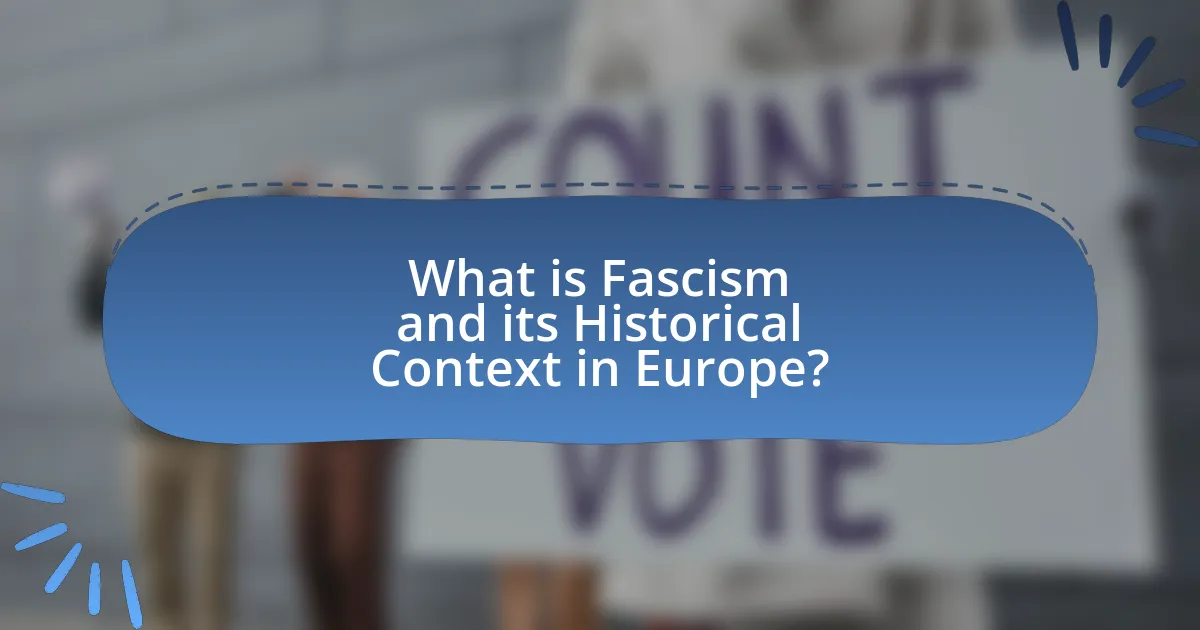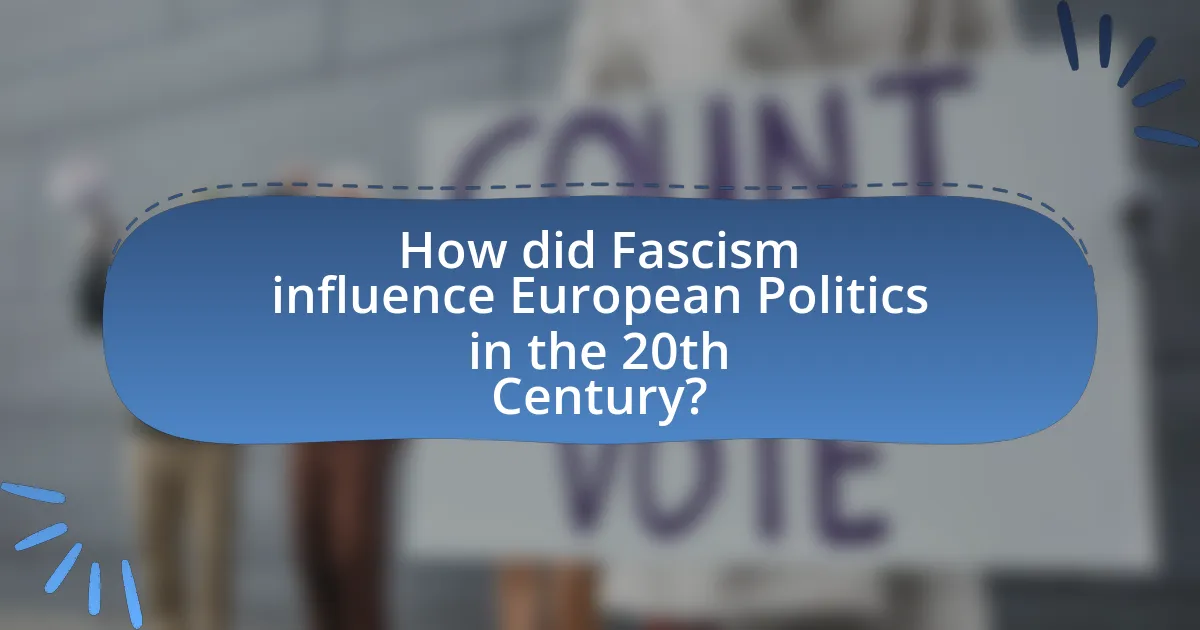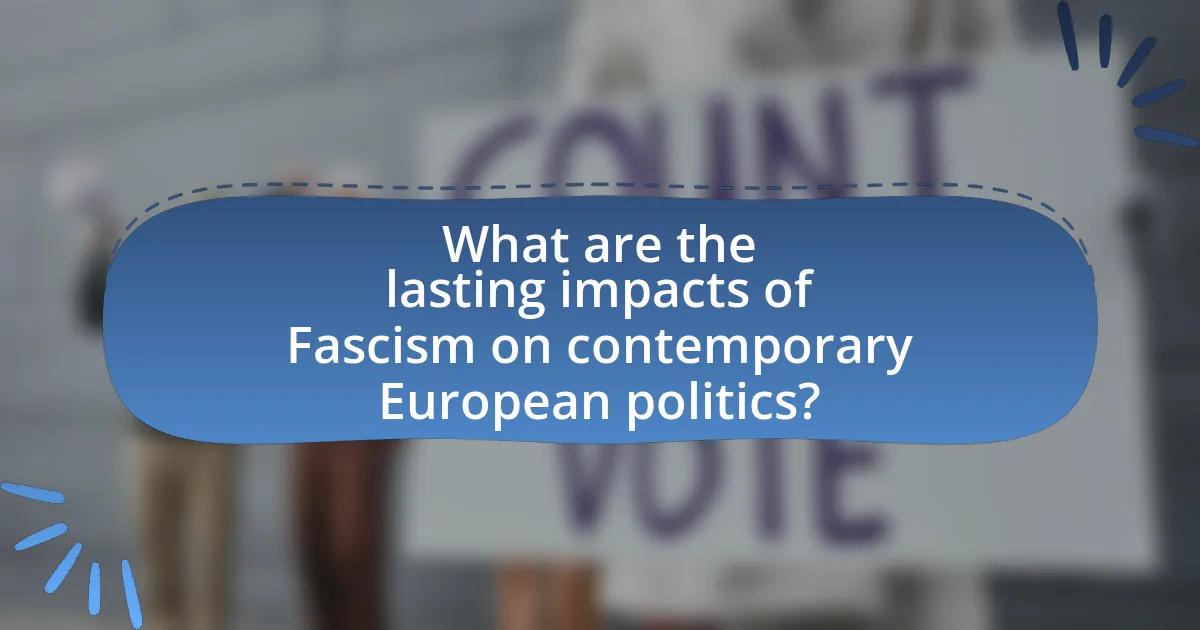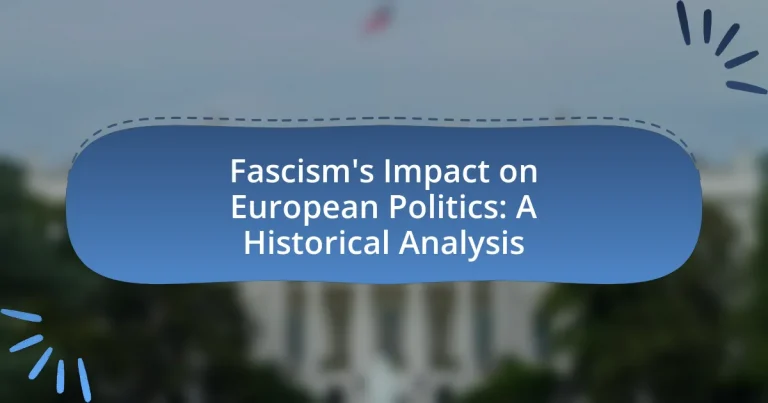Fascism is a far-right authoritarian political ideology that emerged in early 20th-century Europe, primarily in Italy and Germany, characterized by dictatorial power, extreme nationalism, and the suppression of opposition. The article examines the historical context of fascism, its socio-political conditions, key figures like Benito Mussolini and Adolf Hitler, and its defining characteristics. It also explores the impact of fascism on European politics, including the establishment of totalitarian regimes, the influence of nationalism, and the lasting effects on contemporary political movements. Additionally, the article discusses the lessons learned from fascism’s history and the importance of education and civic engagement in preventing the resurgence of authoritarian ideologies.

What is Fascism and its Historical Context in Europe?
Fascism is a far-right authoritarian political ideology characterized by dictatorial power, extreme nationalism, and the suppression of opposition. Emerging in early 20th-century Europe, particularly in Italy under Benito Mussolini and later in Germany with Adolf Hitler, fascism arose in response to social unrest, economic instability, and the perceived failures of liberal democracy following World War I. The Treaty of Versailles in 1919, which imposed heavy reparations on Germany, contributed to widespread discontent, facilitating the rise of fascist movements that promised national rejuvenation and unity. Fascist regimes implemented totalitarian control, promoting militarism and often engaging in aggressive expansionism, as seen in Italy’s invasion of Ethiopia and Germany’s annexation of neighboring territories. The historical context of fascism in Europe is marked by its opposition to communism and socialism, leading to violent conflicts and ultimately contributing to the outbreak of World War II.
How did Fascism emerge in Europe during the early 20th century?
Fascism emerged in Europe during the early 20th century primarily as a reaction to the socio-economic turmoil following World War I. The war left many countries, particularly Italy and Germany, grappling with economic instability, political chaos, and social unrest, which created fertile ground for extremist ideologies. In Italy, Benito Mussolini founded the Fascist Party in 1919, promoting nationalism, militarism, and anti-communism, which resonated with a populace disillusioned by the war’s aftermath and the perceived failures of liberal democracy. Similarly, in Germany, the Treaty of Versailles in 1919 imposed harsh reparations, leading to widespread resentment and the rise of Adolf Hitler and the National Socialist German Workers’ Party (Nazi Party) in the 1920s. Both movements capitalized on fears of communism and economic hardship, utilizing propaganda and mass rallies to gain support. The combination of economic distress, national humiliation, and political instability thus catalyzed the rise of fascism across Europe during this period.
What socio-political conditions contributed to the rise of Fascism?
The socio-political conditions that contributed to the rise of Fascism include economic instability, social unrest, and political fragmentation. Following World War I, many European nations faced severe economic challenges, including hyperinflation and unemployment, which created widespread discontent. For instance, in Italy, the economy struggled with a 2 million unemployment rate in the early 1920s, leading to public frustration and a desire for radical solutions.
Additionally, social unrest was exacerbated by class conflicts and the fear of communism, prompting many to seek authoritarian alternatives. The political landscape was characterized by weak governments and fragmented parliaments, which made it difficult to achieve stable governance. In Italy, the inability of the liberal government to address these issues effectively led to the rise of Benito Mussolini and the Fascist Party, who promised order and national rejuvenation.
These conditions created a fertile ground for Fascism to gain traction, as it capitalized on the public’s desire for stability and strong leadership in the face of chaos.
Who were the key figures in the establishment of Fascist regimes?
The key figures in the establishment of Fascist regimes include Benito Mussolini in Italy, Adolf Hitler in Germany, and Francisco Franco in Spain. Mussolini founded the Italian Fascist Party in 1919 and became the Prime Minister in 1922, establishing a totalitarian regime characterized by nationalism and militarism. Hitler, leader of the National Socialist German Workers’ Party (Nazi Party), rose to power in Germany in 1933, implementing fascist policies that led to World War II and the Holocaust. Franco led a military coup in Spain in 1936, resulting in a dictatorship that lasted until his death in 1975. These leaders played pivotal roles in shaping fascist ideologies and governance in their respective countries, significantly influencing European politics during the early to mid-20th century.
What are the defining characteristics of Fascism?
Fascism is characterized by authoritarianism, nationalism, and the suppression of dissent. Authoritarianism manifests through a centralized government led by a dictatorial leader, exemplified by Benito Mussolini in Italy and Adolf Hitler in Germany, who both eliminated political opposition and controlled various aspects of life. Nationalism is evident in the promotion of a strong national identity, often at the expense of minority groups, as seen in the racial policies of Nazi Germany. The suppression of dissent is enforced through propaganda, censorship, and violence, with organizations like the Gestapo in Nazi Germany and the OVRA in Fascist Italy targeting political opponents and dissenters. These characteristics collectively create a totalitarian state that prioritizes the power of the state over individual freedoms.
How does Fascism differ from other political ideologies?
Fascism differs from other political ideologies primarily through its emphasis on authoritarian nationalism, where the state is prioritized over individual rights and freedoms. Unlike liberalism, which advocates for personal liberties and democratic governance, fascism promotes a centralized, dictatorial power that suppresses dissent and enforces conformity. Historical examples, such as Mussolini’s Italy and Hitler’s Germany, illustrate how fascism employs propaganda, militarism, and a cult of personality to unify the populace under a singular national identity, contrasting sharply with socialist ideologies that seek to redistribute wealth and promote social equality. Fascism’s rejection of class struggle and its focus on national rejuvenation further distinguish it from communism, which aims for a classless society.
What role does nationalism play in Fascist ideology?
Nationalism is a central tenet of Fascist ideology, serving as a unifying force that promotes the supremacy of the nation-state over individual rights and internationalism. Fascists advocate for a strong national identity, often rooted in historical myths and cultural heritage, which they believe is essential for societal cohesion and strength. This emphasis on nationalism manifests in policies that prioritize the interests of the nation, often at the expense of minority groups and foreign nations, as seen in the actions of Fascist regimes in Italy and Germany during the early 20th century. For instance, Benito Mussolini’s regime emphasized the revival of Roman greatness, while Adolf Hitler’s ideology was steeped in notions of Aryan superiority and anti-Semitism, both of which were justified through a nationalist lens.

How did Fascism influence European Politics in the 20th Century?
Fascism significantly influenced European politics in the 20th century by promoting authoritarian regimes that rejected democratic governance and emphasized nationalism. The rise of fascist leaders, such as Benito Mussolini in Italy and Adolf Hitler in Germany, led to the establishment of totalitarian states that suppressed political dissent, controlled the media, and utilized propaganda to maintain power. This shift towards fascism resulted in the erosion of civil liberties and the implementation of aggressive expansionist policies, culminating in World War II. The impact of fascism also prompted a reaction in the form of anti-fascist movements and the eventual establishment of democratic governments in post-war Europe, reshaping the political landscape for decades to come.
What were the major Fascist movements across Europe?
The major Fascist movements across Europe included the National Fascist Party in Italy, the Nazi Party in Germany, and the Falange in Spain. The National Fascist Party, led by Benito Mussolini, established a totalitarian regime in Italy from 1922, promoting nationalism and militarism. The Nazi Party, under Adolf Hitler, rose to power in Germany in 1933, implementing a fascist ideology characterized by extreme nationalism, anti-Semitism, and expansionism, leading to World War II. The Falange, founded in Spain in 1933, sought to create a one-party state and played a significant role during the Spanish Civil War, ultimately influencing Francisco Franco’s dictatorship. These movements collectively shaped the political landscape of Europe in the early to mid-20th century, leading to widespread conflict and significant social change.
How did Fascism manifest in Italy and Germany?
Fascism manifested in Italy and Germany through the establishment of authoritarian regimes that emphasized nationalism, militarism, and the suppression of dissent. In Italy, Benito Mussolini’s Fascist Party rose to power in 1922, promoting a totalitarian state characterized by state control over the economy, aggressive expansionism, and the use of propaganda to cultivate a cult of personality around Mussolini. In Germany, Adolf Hitler’s Nazi Party gained control in 1933, implementing similar totalitarian principles, including the promotion of Aryan supremacy, anti-Semitism, and the use of state violence to eliminate opposition. Both regimes utilized propaganda, censorship, and state-sponsored violence to maintain control and suppress political rivals, leading to significant social and political upheaval in Europe during the early to mid-20th century.
What impact did Fascism have on Spain and other European nations?
Fascism significantly impacted Spain and other European nations by promoting authoritarian regimes, suppressing dissent, and fostering nationalist ideologies. In Spain, the rise of Francisco Franco’s regime after the Spanish Civil War (1936-1939) exemplified the fascist influence, leading to a dictatorship that lasted until 1975, characterized by political repression and censorship. In other European nations, such as Italy under Mussolini and Germany under Hitler, fascism led to the establishment of totalitarian states that prioritized state control over individual freedoms, resulting in widespread human rights abuses and militarization. The alignment of these regimes during World War II further solidified fascism’s destructive legacy across Europe, culminating in significant loss of life and societal upheaval.
How did Fascism affect political structures and governance?
Fascism fundamentally altered political structures and governance by establishing authoritarian regimes that centralized power and suppressed dissent. In countries like Italy under Mussolini and Germany under Hitler, fascist governments dismantled democratic institutions, replaced them with totalitarian systems, and enforced strict control over political, social, and economic life. For instance, the Enabling Act of 1933 in Germany allowed Hitler to enact laws without parliamentary consent, effectively sidelining the legislative body and consolidating his authority. This shift led to the elimination of political pluralism, as opposition parties were banned, and state propaganda was utilized to maintain control over public opinion.
What changes did Fascist regimes implement in government policies?
Fascist regimes implemented significant changes in government policies, primarily focusing on centralization of power, suppression of dissent, and promotion of nationalism. These regimes, such as those led by Mussolini in Italy and Hitler in Germany, established authoritarian control over political institutions, dismantled democratic processes, and eliminated political opposition through censorship and violence. For instance, the Enabling Act of 1933 allowed Hitler to enact laws without parliamentary consent, effectively sidelining the legislative body. Additionally, fascist governments promoted state intervention in the economy, emphasizing autarky and militarization, which aimed to strengthen national sovereignty and reduce dependence on foreign powers. These policies were often justified through propaganda that glorified the state and its leaders, fostering a cult of personality around figures like Mussolini and Hitler.
How did Fascism alter the relationship between state and society?
Fascism fundamentally altered the relationship between state and society by promoting an authoritarian regime that prioritized the state over individual rights and freedoms. Under fascist regimes, such as those led by Mussolini in Italy and Hitler in Germany, the state exerted control over various aspects of life, including the economy, education, and culture, effectively suppressing dissent and promoting a singular national identity. This shift was characterized by the centralization of power, where the state became the primary authority, often using propaganda and violence to maintain control and unify society under a common ideology. Historical evidence shows that fascist governments dismantled democratic institutions and civil liberties, leading to a society where individual interests were subordinated to the goals of the state, exemplified by the establishment of totalitarian control mechanisms and the persecution of opposition groups.

What are the lasting impacts of Fascism on contemporary European politics?
The lasting impacts of Fascism on contemporary European politics include the rise of far-right movements, increased nationalism, and the challenge to liberal democratic values. These movements often draw on historical fascist ideologies, promoting xenophobia and authoritarianism, which can be seen in the policies of parties such as Italy’s League and France’s National Rally. Additionally, the legacy of Fascism has led to heightened vigilance against totalitarianism, influencing European Union policies aimed at preserving democracy and human rights. The resurgence of populism in various European countries reflects a reaction to economic and social issues, echoing the divisive tactics used by fascist regimes in the past.
How does the legacy of Fascism influence modern political movements?
The legacy of Fascism significantly influences modern political movements by fostering nationalist sentiments and authoritarian governance. Contemporary far-right parties in Europe, such as Italy’s League and France’s National Rally, draw on Fascist rhetoric to promote anti-immigration policies and national sovereignty. These movements often utilize symbols and language reminiscent of Fascist ideologies, appealing to a sense of cultural identity and historical grievance. For instance, the rise of populism in various countries can be traced back to the discontent with globalization and economic instability, echoing the Fascist narrative of restoring national pride and unity. This connection is evident in electoral successes, where such parties have gained substantial support, reflecting a resurgence of authoritarian tendencies rooted in Fascist history.
What parallels can be drawn between historical Fascism and current far-right movements?
Parallels between historical Fascism and current far-right movements include the use of nationalist rhetoric, authoritarian governance, and scapegoating of minority groups. Historical Fascism, exemplified by regimes like Mussolini’s Italy and Hitler’s Germany, emphasized extreme nationalism and often portrayed certain ethnic or social groups as threats to national unity. Similarly, contemporary far-right movements frequently employ nationalist language, advocating for the supremacy of a particular identity while targeting immigrants and minorities as scapegoats for societal issues.
Moreover, both historical Fascism and current far-right movements exhibit a tendency towards authoritarianism, undermining democratic institutions and promoting a centralized power structure. For instance, the rise of leaders with populist, authoritarian tendencies in various countries today mirrors the consolidation of power seen in Fascist regimes of the past. This pattern is evident in the erosion of checks and balances and the suppression of dissent, which are common strategies employed by both historical and modern far-right entities.
These parallels highlight a continuity in the ideological underpinnings and tactics used by far-right movements across different historical contexts, reinforcing the notion that the lessons from the past remain relevant in understanding contemporary political dynamics.
How do contemporary European societies remember and address Fascism?
Contemporary European societies remember and address Fascism through education, memorialization, and legislation aimed at combating hate speech and extremism. Educational programs in schools often include curricula that cover the history of Fascism, emphasizing the consequences of totalitarian regimes, such as the Holocaust and World War II, to foster awareness and prevent recurrence. Memorials and museums dedicated to the victims of Fascism serve as physical reminders of the past, promoting reflection and dialogue about the dangers of authoritarianism. Additionally, many European countries have enacted laws that prohibit hate speech and the promotion of Fascist ideologies, reflecting a commitment to democratic values and human rights. For instance, Germany’s strict laws against Nazi propaganda illustrate a proactive approach to addressing the legacy of Fascism.
What lessons can be learned from the history of Fascism in Europe?
The history of Fascism in Europe teaches the importance of safeguarding democratic institutions and civil liberties. Fascism emerged in the early 20th century, notably in Italy and Germany, where authoritarian regimes suppressed dissent, manipulated public opinion, and utilized propaganda to consolidate power. The rise of Fascism was facilitated by economic instability, social unrest, and the failure of democratic governments to address citizens’ needs, as seen in the aftermath of World War I and the Great Depression.
The consequences of Fascism, including widespread human rights abuses and the devastation of World War II, underscore the necessity of vigilance against totalitarian ideologies. Historical evidence, such as the Nuremberg Trials, highlights the accountability required for state-sponsored atrocities. Additionally, the lessons learned emphasize the need for education on the dangers of extremism and the promotion of inclusive political discourse to prevent the recurrence of such regimes.
How can understanding Fascism help prevent future authoritarian regimes?
Understanding Fascism can help prevent future authoritarian regimes by providing insights into the mechanisms of power consolidation, propaganda, and societal manipulation that characterize such regimes. Historical analysis reveals that Fascism often exploits economic instability, nationalistic fervor, and social divisions to gain support, as seen in Italy under Mussolini and Germany under Hitler. By studying these patterns, societies can recognize early warning signs of authoritarianism, such as the erosion of democratic norms and the suppression of dissent. For instance, the rise of Fascism in the 20th century was marked by the dismantling of democratic institutions, which serves as a cautionary tale for contemporary democracies. Thus, a thorough understanding of Fascism equips individuals and institutions with the knowledge to safeguard democratic values and resist the allure of authoritarianism.
What role does education play in combating Fascist ideologies today?
Education plays a crucial role in combating Fascist ideologies today by promoting critical thinking, historical awareness, and democratic values. Through curricula that emphasize the dangers of totalitarianism and the importance of human rights, education equips individuals with the tools to recognize and challenge extremist narratives. For instance, studies have shown that educational programs focused on the Holocaust and other historical atrocities foster empathy and understanding, which can reduce susceptibility to extremist ideologies. Furthermore, initiatives that encourage civic engagement and media literacy help individuals discern misinformation and propaganda, thereby strengthening democratic resilience against Fascist ideologies.
What practical steps can societies take to resist the resurgence of Fascism?
Societies can resist the resurgence of Fascism by promoting education on democratic values and historical awareness. Implementing comprehensive civic education programs can help individuals understand the dangers of totalitarian ideologies, as evidenced by studies showing that informed citizens are less susceptible to extremist propaganda. Additionally, fostering inclusive dialogue and community engagement can counteract divisive narratives, as seen in successful initiatives across Europe that have brought diverse groups together to discuss shared values. Strengthening legal frameworks to combat hate speech and discrimination is also crucial; countries with robust anti-discrimination laws have reported lower incidences of hate crimes and extremist activities. Finally, supporting independent media and fact-checking organizations can help ensure that misinformation does not thrive, as demonstrated by the role of credible journalism in debunking extremist claims during electoral processes.


